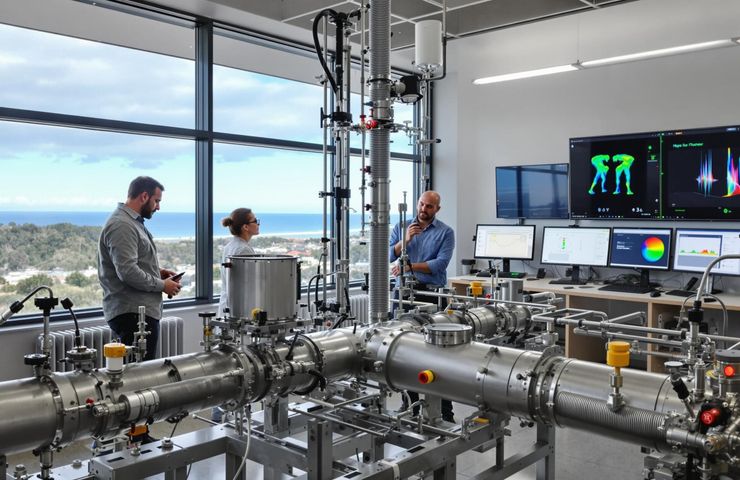
NSW Boosts Hydrogen Pipeline Safety with $650,000 Grant to University of Wollongong
August 11, 2025On August 10, 2025, the NSW Government, led by Premier Chris Minns and Innovation Minister Anoulack Chanthivong, handed a $650,000 grant to the University of Wollongong (UoW). This two-year deep dive into hydrogen pipeline safety—right here in the Illawarra—is all about unpacking how hydrogen transport can fail and delivering practical tools and models to shape the next wave of hydrogen infrastructure.
This funding is a key piece of NSW’s push toward Net Zero and the broader energy transition. By teaming up government, academia and industry, the state is tackling pipeline integrity—a major bottleneck to rolling out green hydrogen at scale in power, transport and heavy industry.
Project at a Glance
- Funding: $650,000 over 2025–2027
- Lead Partner: University of Wollongong (UoW)
- Technical Focus: Pinpointing pipeline failure causes—embrittlement, third-party damage, odorant effects
- Deliverables: Risk assessment software, open-source design guidelines, material performance database
- Collaborators: Inspiring Australia NSW, local industry stakeholders
- Policy Fit: NSW Innovation Blueprint 2035, Industry Policy Net Zero mission
Unpacking Pipeline Risks
Moving hydrogen safely at scale isn’t as simple as pumping natural gas. Its tiny molecules can seep through micro-defects, setting off embrittlement in high-strength steels. Over time, hairline fractures can spread under pressure cycles, raising the chance of sudden bursts. Mix hydrogen with natural gas to use existing lines, and conventional sensors—especially once odorants enter the mix—can miss leaks. Without hard numbers on these tricky interactions, operators are essentially flying blind on maintenance planning, emergency response and insurance premiums.
Lab to Field: Data Collection
To tackle these unknowns, UoW is firing up full-scale pipeline loops and cutting-edge lab rigs. They’ll pressurize sections with pure hydrogen and hydrogen-natural gas blends, then outfit the pipes with acoustic emission monitors, fiber-optic strain gauges and corrosion probes to catch crack initiation and leak progression in real time. Material coupons will go through accelerated aging tests, isolating microstructural changes from hydrogen exposure. All this empirical data feeds into a digital twin, a virtual model of the network where you can simulate everything from ground disturbances to thermal cycling and see risk contours light up on-screen.
From Data to Design
Raw data alone won’t build safe pipelines. The team’s goal is to turn insights into free, easy-to-follow design guidelines—covering the best materials, welding practices and joint configurations tailor-made for hydrogen service. These guidelines will align with ASME, ISO and Standards Australia frameworks, ready to inform upcoming revisions to national and international hydrogen transport standards. Instead of dusty manuals, stakeholders can tap into interactive workshops, downloadable toolkits and hands-on training modules for engineers and safety officers.
Voices from the Frontline
“If we’re serious about scaling this safely, nailing pipeline integrity isn’t optional,” says Anoulack Chanthivong. Max Lu, UoW’s Vice-Chancellor, adds: “Our facility can replicate real-world service conditions like few others—giving us insights you simply can’t get elsewhere.” Officially, UoW’s testing capacity is among a handful globally, though independent verification is still pending.
Strategic and Economic Implications
By providing quantitative risk assessments and validated design tools, this program aims to slash regulatory hurdles and cut insurance premiums—critical for unlocking private investment in green hydrogen projects. Network operators will be able to shift toward predictive maintenance, scheduling inspections and repairs before defects become critical. That approach shrinks lifecycle costs, extends asset longevity and strengthens the business case for hydrogen across major industrial corridors.
Locally, the initiative should spark high-skilled roles in engineering, data analytics and materials science—boosting the Illawarra’s reputation as a hub for sustainable energy innovation. Nationally, Australia can flex these safety credentials on the global stage, offering robust data as a differentiator when exporting hydrogen or related technologies. On the flip side, uncovering unanticipated failure modes might force costly retrofits in existing pipelines, meaning stakeholders will need to weigh short-term expenses against long-term gains.
Governance and Alignment
Anchored by the NSW Innovation Blueprint 2035, this grant exemplifies a governance model focused on targeted research with real industry pathways. It dovetails with the Industry Policy’s Net Zero mission, complete with periodic reviews, open data-sharing mandates and collaboration frameworks—ensuring findings can quickly inform regulatory updates and commercial decisions across public and private sectors.
Illawarra’s Renewable Renaissance
The Illawarra, home to around 827,000 people, has deep roots in coal, steel and manufacturing. Over the past decade, institutions like UoW have pivoted toward sustainable energy and advanced materials research, hosting hydrogen-powered bus trials and demo refuelling stations. With Port Kembla nearby and emerging electrolysis facilities, the region is perfectly poised to anchor a full hydrogen supply chain—from production through domestic use to export.
Next Steps and Forward Look
Key milestones are mapped out: failure-mode mapping by late 2025, full digital twin deployment by mid-2026 and draft design guidelines ready in early 2027. Over the next two years, government, industry and academia will collaborate to integrate these deliverables into regulations and commercial operations.
We’ll be watching for:
- Spin-out companies offering inspection and retrofit services
- Updates to Australian pipeline standards shaped by this research
- Commercial hydrogen offtake agreements tied to validated safety credentials
This targeted investment from New South Wales and UoW could set a new global benchmark for hydrogen infrastructure safety—propelling the transition to a clean hydrogen economy faster than ever.



 With over 15 years of reporting hydrogen news, we are your premier source for the latest updates and insights in hydrogen and renewable energy.
With over 15 years of reporting hydrogen news, we are your premier source for the latest updates and insights in hydrogen and renewable energy.